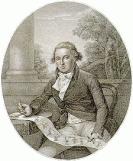 |
|
|
(Below): Henry Bunbury, stipple engraving from the painting by Laurence, c. 1785.  (Below): Laetitia Rookes, etching, by Henry Bunbury, c. 1800.  (Below): A Smoking Club, engraving after Henry Bunbury, 1792. 
|
Henry William Bunbury was another artist with local connections, but a completely different style. He was the younger son of the Reverend Sir William Bunbury, fifth Baronet, who had estates at Mildenhall and Great Barton. When Sir William died in 1764 his eldest son Charles inherited the title and the two brothers went to live at Great Barton Hall, near Bury St. Edmunds. Bunbury was educated locally and at the Westminster School, London. He then went on to St. Catherine's College, Cambridge, and it was there that he began to sketch satirical scenes of college life to amuse his fellow students. In 1769 he went on the Grand Tour of Europe - an essential part of a gentleman's education in the eighteenth century, and his experiences while abroad provided inspiration for many of his humorous compositions. Unlike his more celebrated contemporaries Rowlandson and Gilray, Bunbury eschewed political subjects in favour of purely social satire. In this vein he poked fun at many of the fashions and foibles of the age. Some of the most amusing prints depict the antics of horsemen, and one of his largest works A City Hunt (1780) illustrates a variety of characters on horses or horse-drawn vehicles, creating chaos among the oncoming traffic as they pursue their prey on a busy thoroughfare near London. Other popular subjects include scenes of university life, and episodes derived from his experience as a captain of the West Suffolk Militia. In later life, perhaps to attract more money, he began to produce more sentimental subjects - pastoral scenes and country maids - and illustrations from Shakespeare and the Arabian Nights Entertainment. Although Bunbury moved chiefly in fashionable circles in London he was Groom of the Bedchamber to the Duke of York, son of George III - he frequently returned to the Bury St. Edmunds area to stay with his brother and other relatives. Several of his compositions are based on local scenes, and he also produced caricatures of local tradespeople. Among these is Laetitia Rooke, who kept a coffee house adjoining the Norman Tower which Bunbury often frequented with his rowdy and hard-drinking cronies. Very popular and obviously a 'bit of a lad', he is described disparagingly in later life by the diarist joseph Farington as 'living most of his time a sotting life at Bury in Suffolk'. |
